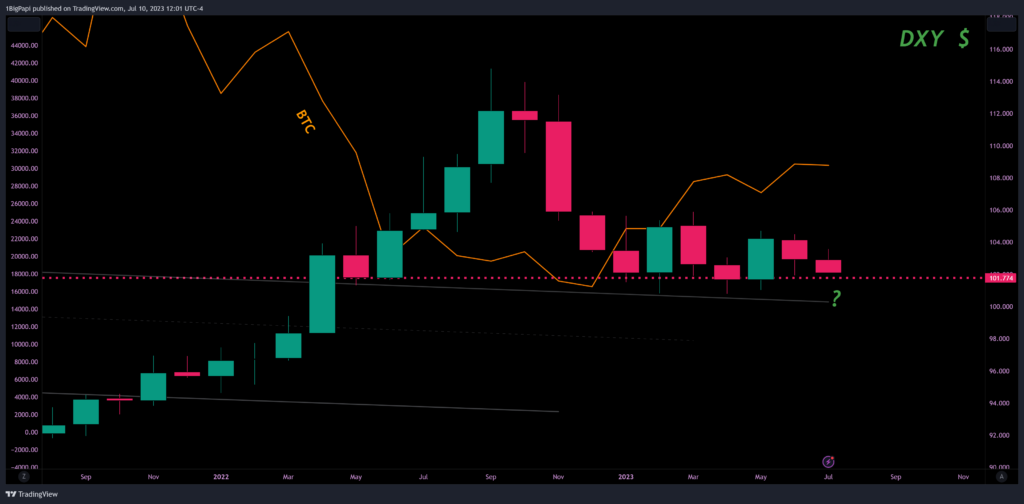Crypto & Economic Calendar
The events listed below inform governments, corporations, traders and investors on the health of the economy. I only list events noted by industry as “high volatility expected” in related markets.
- Monday
- N/A
- Tuesday
- 0200 ET: [EUR] German Consumer Price Index (CPI)
- 2200 ET: [NZD] Interest Rate Decision
- Wednesday
- 0830 ET: [USD] Core CPI (MoM), CPI (YoY & MoM)
- 1000 ET: [CAD] Interest Rate Decision
- 1030 ET: [USD] Crude Oil Inventories
- Thursday
- 0200 ET: [GBP] Gross Domestic Product
- 0830 ET: [USD] Initial Jobless Claims
- 0830 ET: [USD] Producer Price Index (PPI)
- Friday
- New Zealand Holiday – New Years Day
Bitcoin $30k Respected into Weekly Close

Summary: Bitcoin continues to range with a measure of uncertainty, between $29k and $31k intraweek, but respecting $30,000 as the local support into weekly closes. BlackRock’s ETF move signals a rising interest in Bitcoin as an investment, which will likely provide a boost to Bitcoin’s price if approved. In the meantime, macroeconomic events will remain of higher significance, with several significant events this week, including the CPIR report on Wednesday. A positive report would be bullish for crypto and equities.
Bitcoin Levels: $30k marked the most important support level in 2021’s bull market. $30k withstood several retests, until the Luna meltdown in mid 2022. Afterwards, Bitcoin didn’t touch $30k again until April 2023, when it began to range between $25,000 and $30,000. This continued until the BlackRock news broke the indecision, sending price on a 20% rally. Current levels to monitor:
- Immediate support: ~$30,000
- Current value range: $29,000-$30,700 [historically bearish range due to the massive distribution during the Luna meltdown; optimistically flipping to accumulation range now]
- Support levels: $28,900-$29,000; $27,700; $26,300, $25,500
- Resistance levels: $31,300-$32,000; $34,000-$36,500; $37,500; $40,000
Bull Perspective: BlackRock’s request for a Bitcoin Spot ETF remains the primary catalyst for improved bullish sentiment, but macroeconomic factors matter too. While they are marginally improving, a bad month could still stifle upward momentum. Closing the weekly at or above $30k remains the best scenario for bulls; however, intraweek retests of key levels is likely and healthy.
- 23.6% fibonacci retracement at $29,000
- 38.2% retracement at $28,300
- 50% at $27,500; this is where the “bull market support” moving averages (20w & 21w) are currently
- Under $27,000 is unlikely given the current sentiment
Bear Perspective: Regulatory uncertainty still hangs over the crypto market, and the much touted ETF requests are not guaranteed. Additionally, big players like BlackRock isn’t all good news – many have a reputation for manipulating markets.
Example- around a year ago JP Morgan was fined nearly $1 billion dollars for manipulating commodity markets. For good reason we should be cautiously optimistic over the ETF news, and also hope that the SEC and CFTC (US regulators) don’t try to crush traditional crypto players to make room for their friends in traditional financial markets.
From a price action perspective, $30,000 was is logging a double top so far, with two taps of the resistance around $31.5k in the past month.
US Dollar Index (DXY)

The US Dollar Index continues to flirt with a historically bearish level around 101. Seven times in recent decades, 101 rejected the recovery or upside continuation of the DXY, sending it much lower for at least a year. A descending resistance into a flat support is generally a higher confidence bearish trend, adding weight to the bearish thesis for DXY.
While the DXY is a complex index, and a lot of external factors impact its value, you can look at the relationship between DXY and Bitcoin simply – they almost always move inverse to each other. When DXY is up, BTC is down; and the opposite is true.
While the DXY can continue to range near/above 101, it appears to be in a slow downtrend. Coupled with Bitcoin’s rising sentiment and next year’s halving, things are shaping up for a potentially bullish 2024.
Market Sentiment

The Cryptocurrency Fear and Greed Index peaked at 69 in April, after two months of recovering price and consumer confidence. A series of SEC actions at that time shook investors, bring it down as low as 41 in June. Sentiment quickly recovered on the back of the BlackRock ETF news.
The overall risk appetite, including that of crypto markets, appears to be growing. But continued appetite will be dictated more by the macroeconomic climate than crypto regulators, so monitoring of the US Fed and European Central Bank (ECB) as leading sentiment indicators is important.
Trading Tips
Think about self-custody of your crypto, using technology like Ledger or Trezor. Storing your crypto on exchanges leaves it vulnerable to loss, if the company goes out of business. It also is used by exchanges to offer derivative services, which isn’t always beneficial to traders. Here are five reasons to consider hardware wallets:
- Control and Security: Hardware wallets are offline wallets that provide users with full control over their cryptocurrency assets, reducing reliance on third-party services which can be vulnerable to hacks or service disruptions.
- Privacy: With self-custody, users maintain their financial privacy. In traditional banking and some cryptocurrency exchanges, transactions and account details are known to the institution, which allows them to do things like sell their order book info to whales and institutions, or like FTX – they traded against their own customers.
- Direct Ownership: Self-custody of cryptocurrency means direct ownership. It represents the core principle of cryptocurrency – the idea of decentralization and eliminating the middleman in financial transactions. The user owns the keys and therefore owns the coins.
- Less Trust Dependence: With hardware wallets and self-custody, the security of your crypto assets doesn’t depend on the promises or competence of a third party. This becomes particularly important considering the history of security breaches on major crypto exchanges where users have lost their holdings. The author can speak to that one personally – I lost a lot of my portfolio when a third party who had custody of my coins was hacked
- Recovery and Redundancy: Hardware wallets often support recovery phrases to restore wallet data, allowing users to recover their assets in case the device gets lost, stolen, or damaged. This feature provides an extra layer of security and comfort for the user, knowing that their assets can be recovered and aren’t tied to a single piece of hardware.
If you enjoyed this article and want more hot takes and interesting posts about the economy, web3, crypto, decentralized finance, NFTS and more – you can follow Papi on Twitter at https://twitter.com/1MrPapi.
Disclaimer: Nothing found on this website, or any sources linked to this website includes financial advice of any sort. We are not certified financial advisors, use our content at your discretion as entertainment, and as an educational resource. Do your own research.
